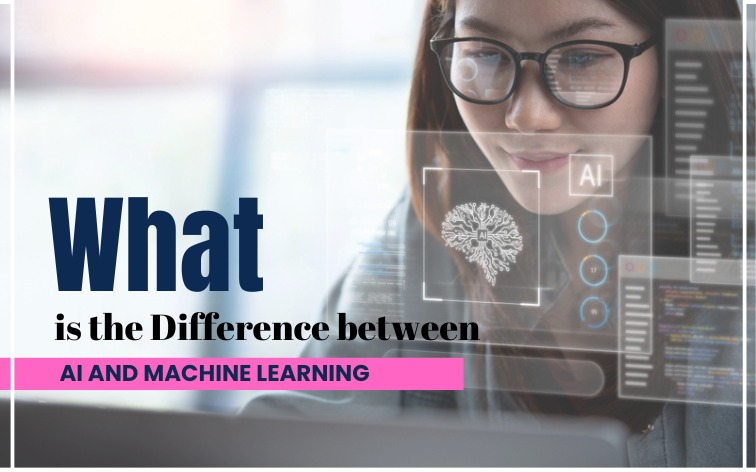
Understanding the difference between AI and Machine Learning is crucial in today’s technology-driven world. While these terms are often used interchangeably, they represent distinct concepts with unique applications and capabilities. Artificial Intelligence rests on the broader vision of creating intelligent machines, while Machine Learning serves as a specific subset that enables computers to learn from data without explicit programming. This fundamental distinction shapes how businesses implement these technologies and how they impact our daily lives. In this article, we’ll clearly explore the difference between AI and machine learning.
In Mahalakshmi Tech Campus, we are providing the best AI program in Chennai, where students learn all the major concepts, systems and frameworks.
What is Artificial Intelligence?
Artificial Intelligence (AI) represents the comprehensive field of computer science dedicated to creating systems that can perform tasks typically requiring human intelligence. AI encompasses various technologies including natural language processing, computer vision, robotics, and expert systems. The goal of AI is to develop machines that can reason, learn, perceive, and make decisions autonomously. AI systems can be categorized into narrow AI (designed for specific tasks) and general AI (hypothetical systems with human-like intelligence across all domains). From virtual assistants like Siri and Alexa to autonomous vehicles and recommendation engines, AI has become integral to modern technology infrastructure.
What is Machine Learning?
Machine Learning (ML) is a specialized subset of artificial intelligence that focuses on algorithms and statistical models that enable computer systems to improve their performance on specific tasks through experience and data analysis. Rather than being explicitly programmed for every scenario, ML systems learn patterns from training data and make predictions or decisions based on new, unseen data. The three primary types of machine learning include supervised learning (using labeled data), unsupervised learning (finding patterns in unlabeled data), and reinforcement learning (learning through trial and error with rewards). Popular ML algorithms include neural networks, decision trees, support vector machines, and deep learning models that power applications like image recognition, fraud detection, and personalized recommendations.
Also read: Basic Machine Learning Concepts
These definitions allow you to understand how these two subjects or concepts are related to each other. Let’s find out the difference between AI and Machine learning, in a clearest manner.
Key Differences between AI and Machine Learning
In the below table, you can clearly understand about the difference between AI and Machine Learning:
| Aspect | Artificial Intelligence (AI) | Machine Learning (ML) |
| Definition | Broad field creating intelligent machines | Subset of AI focused on learning from data |
| Scope | Encompasses all intelligent systems | Specific to data-driven algorithms |
| Approach | Rule-based and learning-based systems | Statistical and algorithmic learning |
| Data Dependency | May or may not require large datasets | Heavily dependent on quality data |
| Implementation | Expert systems, robotics, NLP, computer vision | Neural networks, decision trees, clustering |
| Examples | Siri, autonomous cars, game-playing AI | Netflix recommendations, spam filters |
| Goal | Simulate human intelligence | Improve performance through experience |
| Complexity | Can include simple rule-based systems | Requires sophisticated algorithms |
| Learning Method | Pre-programmed rules + learning capabilities | Continuous learning from data patterns |
In the above table, you can understand the difference between AI and machine learning clearly since we have tocuhed various aspects.
How AI and Machine Learning Helps Companies?
AI and Machine Learning revolutionize how companies operate by automating complex processes, analyzing vast datasets for actionable insights, and optimizing resource allocation. Companies leverage these technologies to reduce operational costs, improve customer experiences, and accelerate innovation cycles. AI-powered chatbots handle customer service inquiries 24/7, while ML algorithms optimize supply chain management, predict equipment maintenance needs, and personalize marketing campaigns. Financial institutions use ML for fraud detection and risk assessment, healthcare organizations employ AI for diagnostic assistance, and e-commerce platforms utilize recommendation engines to boost sales conversion rates.
How AI and ML Shape the Future?
AI and Machine Learning are fundamentally reshaping the future landscape across multiple dimensions. In healthcare, AI-driven drug discovery accelerates pharmaceutical development, while ML-powered precision medicine personalizes treatment plans. Autonomous vehicles powered by AI will transform transportation infrastructure, smart cities will optimize energy consumption through ML algorithms, and AI-assisted education will provide personalized learning experiences. The integration of AI and ML in climate science helps predict environmental changes and optimize renewable energy systems. Having an hands-on experience in AI and ML can lead you to have rewarding career in the future.
Conclusion
The difference between AI and Machine Learning represents more than just technical distinctions, it reflects the evolution of intelligent systems from broad conceptual frameworks to precise, data-driven implementations. While AI encompasses the ambitious vision of creating machines that think and act like humans, Machine Learning provides the practical tools and methodologies to achieve specific aspects of this vision through continuous learning from data. Understanding the difference between AI and machine learning is essential for businesses, researchers, and individuals navigating our increasingly AI-powered world.
FAQs on Difference between AI and Machine Learning
Here are the frequently asked questions (FAQ) for the topic – difference between AI and machine learning.




